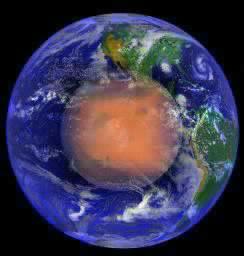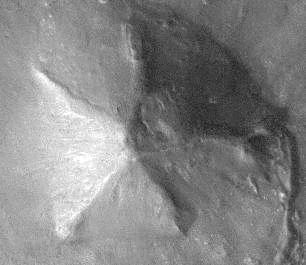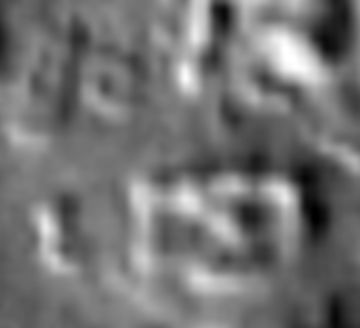 Cydonia Quest C Image Enhancements C An Experimental Analysis of the First Infra-red Image of Cydonia C Introduction. In an article published on their web-site on the 28th February 2002 the Enterprise Mission predicted that the Mars Odyssey's THEMIS infra-red (thermal) camera could produce interesting evidence of artificiality at Cydonia when used in its night-time mode of operation, (see µµµ). The thinking behind this claim was the THEMIS camera's ability to "see through" soil layers to more solid rock formations buried beneath. The principle behind this ability is that solid material retains heat better than loose material such as sand. As the Martian night progresses loose overlying deposits quickly give up their heat, but buried rock formations stay warm and literally glow through the overlying loose material from the standpoint of thermal imaging. The Enterprise Mission's prognostications were partly confirmed on the 1st March 2002 when the Mars Odyssey team released a night-time image of the Hydaspsis Chaos system of canyons which revealed striking features hidden beneath loose material covering the canyons' walls and floors, (see image below). It has even been proposed by the Enterprise Mission that the formations in Hydaspsis Chaos may be candidates for artificiality based on what was revealed, (see µµµ).
|
| C Ccccccccccc c What can the new daytime infra-red image of Cydonia tell us? On the 24th July 2002 the Mars Odyssey team published the first daytime infra-red image of Cydonia, capturing the "Face", "Fort", D&M Pyramid and the "Citadel", (click "stargate" µµµ). Mars Odyssey's daytime infra-red (IR) images look remarkably like normal pictures capturing visible light. This is not surprising as surfaces receiving a lot of sunlight be will be warmer that surfaces in shadow. In fact daytime IR images actually show less detail than a comparable picture at the same resolution using visible light. A visible light picture provides a great deal of detail about the surface of an object through a wide range of different reflected shades. However, because heat is conducted through materials the surface of the same object will tend to be almost uniformly warm. The "shades" of infra-red re-radiated from the surface will therefore be fewer than in the case of visible light. One only has to think of the difference in detail between a normal photograph of a person and a thermal image of that same person to realise this. ...And yet... Whilst perusing the new image this researcher couldn't help but notice that the "heat shape" of the D&M Pyramid did not match the actual shape revealed in the Mars Odyssey visible light image released in April 2002. The difference was in the West and South facets of the D&M where the separating ridge line was invisible, but other thermal features were very prominent on the West facet. It therefore seemed to be a good idea to enlarge and subject the D&M to extreme contrast enhancement methods to accentuate small heat differences on the sunlit surfaces. (The TIF format file version of the image was used for this exercise). As the result below shows there are interesting patterns of warmth and relative "coolness" in the image that suggest hidden structure beneath the surface of the West facet, (the left hand facet in the image). There is even some symmetry between the two halves of the West facet if it is divided along a line running from the peak of the D&M to the ground. (The red lines in the image show the placement of the actual perimeter and ridge lines of the D&M). C cccccccccccccccccccccccccc
c If an image of the D&M is made with much less aggressive contrast enhancement then another interesting item of symmetry is revealed by this new thermal image. Since the D&M Pyramid was first discovered on the Viking images it has been observed that there is a vaguely triangular depression near the top of the East facet. It has been suggested that this may be subsidence due to a roof collapse in an internal artificial chamber. This feature can be seen in the Mars Odyssey visible light image below, left. The outlines of this feature can also be made out in the infra-red image of the D&M below, right. The interesting thing is that this depression in the East facet is symmetrically matched by a large cool spot at the top of the West facet. c CCCCCC C A possible explanation for this cool spot anomaly is that some of the heat hitting this part of the West facet is leaking away into an internal chamber before it can be re-radiated back to the external environment. We therefore have two separate types of evidence that two hollow chambers were/are arranged symmetrically and architecturally near the top of the D&M. Is there a test for whether the above image enhancements of the D&M are showing actual hidden features? One way of assessing whether these apparent D&M structural elements are real is to see what structural looking features seen in visible light look like in this new daytime IR image. Happily the new daytime IR image also captures the "Citadel", an anomalous mountain which may be a large arcology with collapsed chambers, (see middle image below). The sunlit slope of the "Citadel" in this Viking image exhibits a slightly raised grid-like pattern with the possibility that some kind of roof is sagging between hidden supporting walls. The first of the two images below shows the "Citadel" as it appears in the new daytime IR image. The third image zooms in on the sunlit slope where the grid effect is observed in the Viking picture and subjects it to the same ultra-contrasting that was applied to the D&M. It can be seen that the thermal image creates the impression of a cell-like arrangement of open chambers consistent with the grid seen in Viking's visible light image of the "Citadel's" surface. The architectural looking arrangement of the cool and warm spots on this slope of the "Citadel" provides some circumstantial evidence for the possible existence of artificial chambers beneath the surface. It certainly shows that the IR images can pick up on structural looking details in a different way than visible light cameras can. c ccccccccccccccc cccccccccccccccccccccccccccccc ccccccccc c An interesting surprise. The enlargement below shows an interesting anomaly which appears in the extreme South of the new Cydonia IR image. This is an almost perfectly rectangular arrangement of walls and mounds almost as large as the "Face". The space enclosed within the rectangle is further sub-divided by internal walls. It has the appearance of some gigantic ruined building. It would be very interesting to see what it looks like when imaged by the higher resolution visible light cameras of the Mars Odyssey or the Mars Global Surveyor. C ccccccccccccccccccccccccccc C Conclusion. Even though the IR imaging system of the Mars Odyssey only has a resolution of 100 metres per pixel its capabilities to find evidence of artificiality when used in the night-time mode seem to be awesome. The preceding speculative analysis of the first daytime IR image of Cydonia suggests that a full night-time IR survey of this enigmatic region would discover many new anomalies. Here is checklist of some of the things that Cydonia enthusiasts would hope might be uncovered in night-time IR images. (A) The edges of things such as the "Face", D&M Pyramid and the formations in the "City" are buried under sand and debris. If these formations are artificial then we may be able to see the buried boundaries of these anomalies. These boundaries in turn may be very straight edged and suspiciously geometrical. c µ Return to the Enhancements page
|







